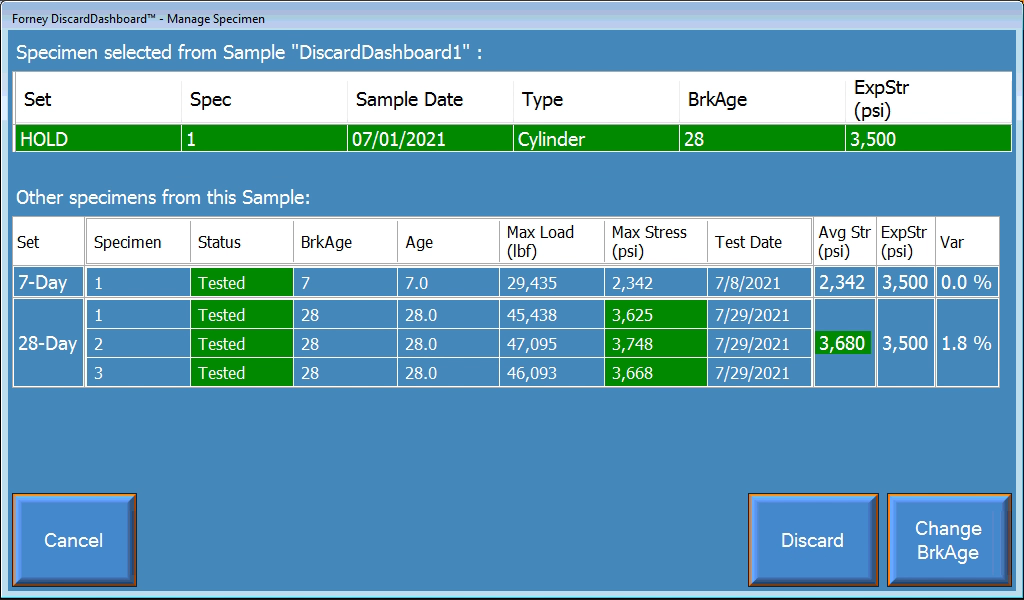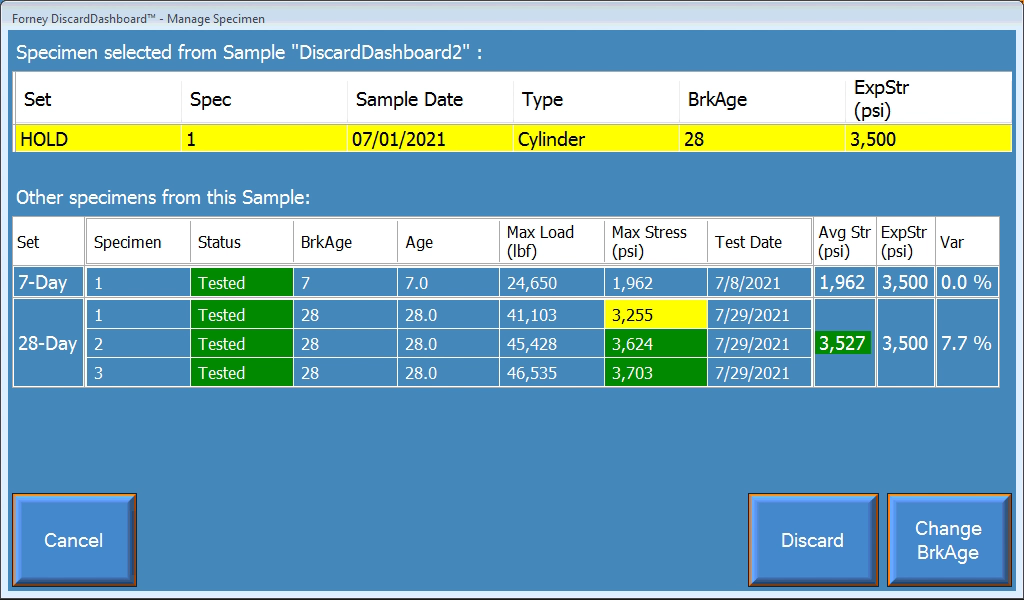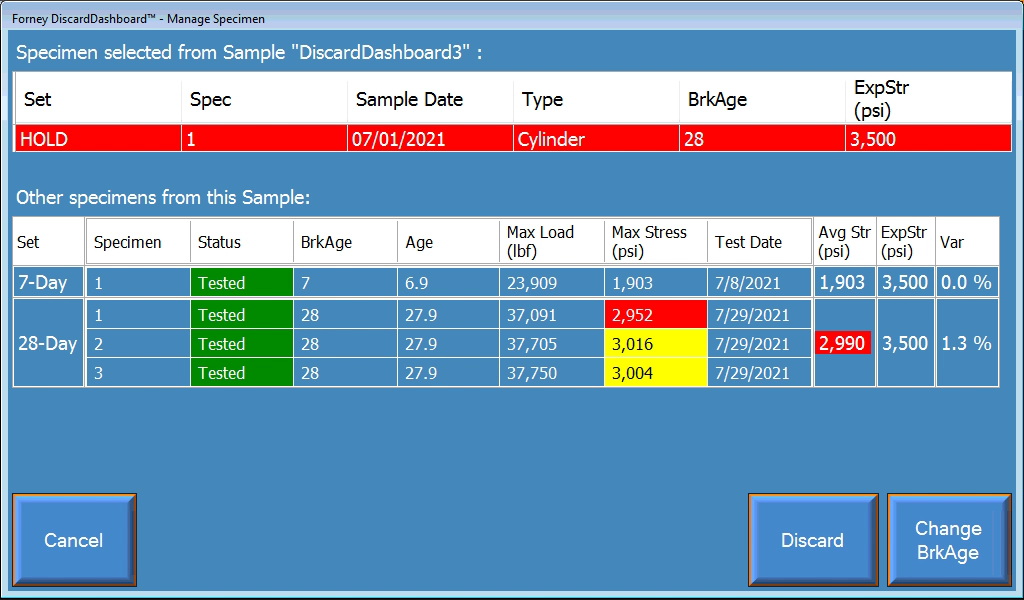
Throwing away a test specimen from your curing room isn’t a problem. Until you throw away the wrong one. Here’s how you can keep your curing room organized, in compliance and on track with projects by automating concrete curing room management.
Construction materials testing (CMT) is vital to the success of a building or infrastructure project. The process involves physically testing materials to verify they meet expected strength requirements.
Concrete gains strength (hardens) with curing. So, a number of specimens from a sample are prepared to be tested at appropriate time intervals. The necessary expected strength requirements are usually achieved 28 days after pouring and verified by test. If tests indicate satisfactory performance, any remaining specimens can be discarded. But, if the concrete hasn’t met the necessary strength requirements at the 28-day mark, labs need to conduct additional tests to verify the strength at a later date—usually at 56-days. These tests are conducted on the so-called “hold” specimens prepared at the outset of testing against just this sort of eventuality.
So, not all cylinders in the curing room need to be tested. Managing which to keep and which to discard is an important function. Mistakes can be expensive. That’s why proper curing room management is so important.
If the concrete specimen you need to test isn’t there because it’s been discarded, you’re stuck with the last resort: an expensive core drill. Costly for lab owners and bad for business, and a time-suck and headache for project owners and general contractors who are trying to move their project forward on time.
Today, most labs follow a tedious process to determine which test specimens are no longer needed from a lab’s curing room. Some comb through reams of data from previously tested cylinders in the concrete sample to see if the sample has met strength requirements. Others may simply throw away any that look really old. Either way, there is a non-zero risk of an inadvertent discard.
For lab supervisors and technicians at third-party testing organizations who are responsible for the concrete curing room and cylinder testing, the process of discarding cylinders is cumbersome but routine—until a major mistake happens. This is reason alone to automate your concrete curing room management. Let’s drill into five specific benefits of automation in this area.
5 Reasons to Automate Concrete Curing Room Management
#1. Stay Compliant
First and foremost, automated curing room management helps labs stay compliant with American Concrete Institute (ACI) Standards.
The American Concrete Institute (ACI) provides major, general purpose concrete standards. In the U.S., ACI 318-95, “Building Code Requirements for Structural Concrete,” covers minimum requirements for the materials, design and detailing of structural concrete buildings and, in some cases, nonbuilding structures. This includes testing requirements.
Simply put, you have to have the proper specimen in the first place to be ACI compliant. If you’ve thrown it away, you’ll have to core drill and test a new specimen to provide compliant testing.
#2. Save Time
Like other areas involving automation and data management, improved concrete curing room management saves time from the manual discard decision-making process.
Instead of flipping through strength reports to see if a subsequent test is required, lab technicians can simply push a button and automatically retrieve the right information that allows an informed discard decision (more on how this works, soon).
Free: The Ultimate Guide to Truly Automated Testing
GET GUIDE
#3. Organize Your Concrete Curing Room
An automated curing room management process helps labs stay organized and be more intentional about specimen upkeep.
Instead of having a room overflowing with old cylinders that you periodically clean out, you decide regularly and intentionally what to keep or throw away. This keeps your curing room from getting out of hand with old cylinders and makes you look better to potential clients. And a clean, organized room is a safer room.
#4. Meet Client Expectations
At the same time, this workflow process can help labs better meet client expectations. That’s because you can provide reliable, trouble-free and trustworthy support to project owners and general contractors.
You and your clients have the confidence that you will be able to provide clients high quality service. Project owners have the surety that you will deliver on what they need, on time.
#5. Get Peace of Mind
Finally, an automated workflow process provides peace of mind for all project stakeholders.
With discard management supported by an automated workflow, you trust that cylinders can’t be mindlessly discarded by mistake. The risk of an inadvertent discard (and expensive core drill) drops dramatically.
Plus, with an automated system, you have sample data and the full history of tests at your fingertips, informing lab technicians so they can confidently verify concrete strength and discard the right hold cylinders.
The benefits are clear. But how do you actually achieve this automation, and what does it look like in practice?
How to Automate Concrete Curing Room Management
Concrete labs everywhere know that core samples are the last and least desirable resort. That’s why more and more organizations are finding ways to automate and secure the curing room and cylinder disposal process.
How Braun Intertec Created a High Productivity,
Low-Cost Environment with Automation
READ CASE STUDY
It starts by implementing a cloud-based, integrated construction materials testing software. This platform consists of a database, an interface for accessing and communicating with that database, and a way to integrate everything with your testing machine. All in all, this solution automates how data moves through the testing workflow and, in the process, better structures and secures the data forever.
This includes data that informs the discard decision-making process.
Here’s how it works.
#1. Identify Cylinder
With the support of CMT software, your cylinders will all be tied to unique IDs. So, you can either scan the label on the cylinder or select the specimen ID on a connected tablet or human-machine interface (HMI) to retrieve the full history of tests of a sample.
#2. Select “Manage”
After identifying the cylinder, the screen will show sample history. On that screen, you can select “manage,” which takes you to the automatic discard feature.
#3. View Results & Act
On the screen, you will see one of three results following an easy-to-understand color system.
For example, for concrete with an expected strength of 5,000 psi:
GREEN: Safe to Discard

A green result means the cylinder is safe to discard. Following our example, the average of the three 28-day tests is above 5,000 psi, and there’s not one individual specimen that is less than 5,000 psi.
YELLOW: Okay to Discard, Requires Verification

Yellow means the cylinder can be discarded according to ACI Standards, but it requires additional confirmation. One specimen in the 28-day set might have broken low (but within ACI’s tolerable range).
ACI Standards also call for an average of three 28-day results for 4” x 8” cylinders, or two results for 6” x 12” cylinders. If there are 28-day results that meet strength requirements, but there are not the proper number of cylinders tested, the scanned cylinder will be presented in yellow.
At his point, it’s up to the lab to decide if they’re comfortable with these results enough to discard. You have to intentionally decide to “okay” the discard before moving on.
RED: Do Not Discard

If the average of three tests for 4” x 8” cylinders is less than 5,000 psi and/or any individual specimen is less than 4,500 psi, ACI Standards say that the concrete has not met expected strength.
So, the technician will be alerted to hold the cylinder. The technician can change the age to break to a later date from the same screen, reprint the label and set it in the concrete curing room until the next test date to see if it meets the right strength at that time.
There are multiple steps required to discard this cylinder, preventing accidental discard.
Conclusion
Automated concrete curing room management is helpful for all testing labs, large and small, as well as the project owners and contractors that rely on them.
While technicians still have to intentionally go into the curing room to scan, verify and discard cylinders, the automated decision-making workflow ultimately saves you time, makes for a safer workplace, provides peace of mind to all concerned, and helps you stay compliant, organized and on target with client expectations.
Discard Dashboard is a free tool included with ForneyVault that automates and verifies the discard management process of test specimens.
If you’re a current ForneyVault subscriber, check out our video to see how you can start using Discard Dashboard today. If you’re not a subscriber, see how you can reduce the risk of inadvertent discard and secure all other testing data by requesting a free demo.